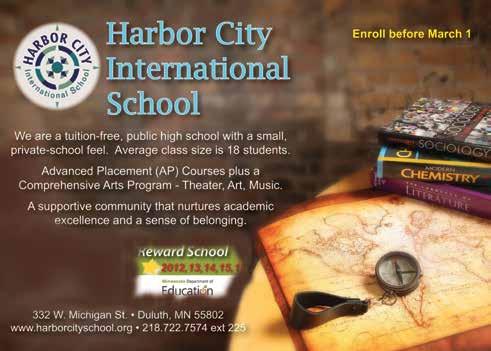
4 minute read
Teaching Teachers
by Bob Ashenmacher
Preparing the teachers of tomorrow is an inspiration for Brenda Fischer, the Dean of the School of Education at The College of St. Scholastica.
“I often hear from school administrators, ‘We are so happy to get teachers from St. Scholastica. We love them,’” Brenda said. “I think it’s because our students get the combination of state-of-theart professional preparation and the values that make St. Scholastica unique.”
Brenda is proud of both parts of the St. Scholastica experience.
Brenda Fischer
“The technology and techniques of effective teaching are changing all the time,” she said. “I want to ensure our teachers are not just ready for the classroom but are prepared to be leaders when they go out in the schools.
“At the same time, we are successful only if our graduates are living the values they have encountered here.” St. Scholastica calls them Benedictine values in honor of the College’s founders, the Catholic Benedictine Sisters of St. Scholastica Monastery. They are: community, respect, hospitality, stewardship and the love of learning.
Brenda’s other priority is to strengthen partnerships with the many area schools that welcome St. Scholastica’s student teachers and hire them upon their graduation.
“These are important reciprocal relationships,” Brenda said, “and we want to support the schools in every way we can.”
Brenda’s affinity for teachers and teaching goes back to childhood. She was raised in Hinckley, the second of four children. Her father and mother were both teachers.
“We had a blackboard in our basement and I remember ‘teaching’ the neighborhood kids and my siblings as my students.”
She was athletic — dad was also a coach and an athletic director — and played basketball and volleyball. Summers included work as a lifeguard.
“I taught swimming lessons for many years, and that was when I realized that I really did love to teach. Here were these little kids who couldn’t do something, and by the time we were done they could do it. That was very satisfying.”
Brenda played flute in high school and college, including for a time with the Twin Ports Wind Ensemble. She hopes to take it up again when her life isn’t quite so busy.
Going into education was “a natural fit,” Brenda said. “I enjoyed reading, and I enjoyed math — it’s kind of nerdy to say but I loved being a student. I always liked school.”
She graduated from Moorhead State University in three years and promptly went on to earn a master’s degree in education from St. Mary’s University of Minnesota.
She met her future husband, Aaron, when “we were the only second-grade teachers in Willow River, Minnesota. He was actually on the committee that hired me. We joke that after we got married, you either had Mr. Fischer, Mrs. Fischer, or you had to open enroll elsewhere.”
Aaron went on to get his administrative license to be a principal, and he’s now the superintendent of schools in Esko, where the family resides.
When sons Ben, now 18, Quinn, 17, and Riley, 14, were small, Brenda took a leave from teaching in the elementary classroom so she could spend more time at home with her boys. It was at that time that she started teaching adult learners part-time and found it just as satisfying as teaching children. She completed work on her doctorate at the University of Minnesota in May 2011, and that fall started at St. Scholastica.
Balancing home life and her career has required vigilance.

“I’ve learned to prioritize what really matters. Sometimes the things a person can get hung up on really aren’t that important. Aaron and I have always been supportive of each other, adjusting when professional responsibilities have been more impactful for him, or for me. Regardless of how hectic things get, though, my family always comes first. Always.”
Brenda taught education courses at St. Scholastica in face-to-face settings, in an accelerated blended format (inperson and online), and in a fully online master’s program.
In 2014 she was appointed chair of the undergraduate education program, overseeing programs on the Duluth campus (elementary education, five secondary education programs and two K-12 programs) and the elementary education degree completion program — which she developed — on
Continued on page 20
St. Scholastica’s St. Paul campus.
She also oversaw development of an academic behavior strategist license program to help address the shortage of special education teachers in Minnesota and across the country.
Last August she reached a new professional height, being named to her current position.
“Dr. Fischer is a collaborative and innovative educator who has fostered positive change on behalf of students and faculty in all of her areas of engagement — as a faculty member, a chair, and now as dean of the School of Education,” said Dr. Wolfgang Natter, St. Scholastica’s vice president for Academic Affairs. “I am delighted to have the opportunity to work closely with Dean Fischer in advancing the School and the College.”
Brenda leads a major academic enterprise. St. Scholastica’s School of Education has four main programs — traditional undergraduate, master of education, degree completion and graduate teaching licensure, with locations in Duluth, St. Paul, St. Cloud and online. The School has about 160 graduates a year.
And Brenda’s professional contributions at St. Scholastica go beyond the School of Education. For example, she recently co-chaired one of the task forces that are helping guide the College’s Strategic Planning process.



She said being engaged across campus feels natural.
“Honestly, from the first day I stepped on this campus, it has felt like home. It’s the relationships, the people here. The (Benedictine) Sisters have a welcoming presence that you can feel. And everyone is supportive. Every department works together to help each other regardless of what their role is at the College. I think that’s unique. It’s a sense of community that I haven’t experienced elsewhere.”
She has learned something about leadership.
“The biggest part is working with people collaboratively, to move forward and accomplish a goal. It takes everybody being on board.
“As a brand-new teacher, I thought it was all about the content. Teaching children ‘the stuff’ — the reading, the math, the science. As I grew more experienced, I realized it was much more about the relationships. Once students understand you, trust you and know that you care about them, they buy into it; they want to learn from you. Until you break down the barriers, the content is really hard to get to.”
A personal story illustrates the point well. Brenda’s favorite teacher from her own school days is Patrick Riley, who taught social studies in Hinckley.
“His class was very challenging, content-heavy, but I embraced it because I knew he cared about all the students. My dad died unexpectedly when I was 15. I distinctly remember the conversation Mr. Riley had with me that was








